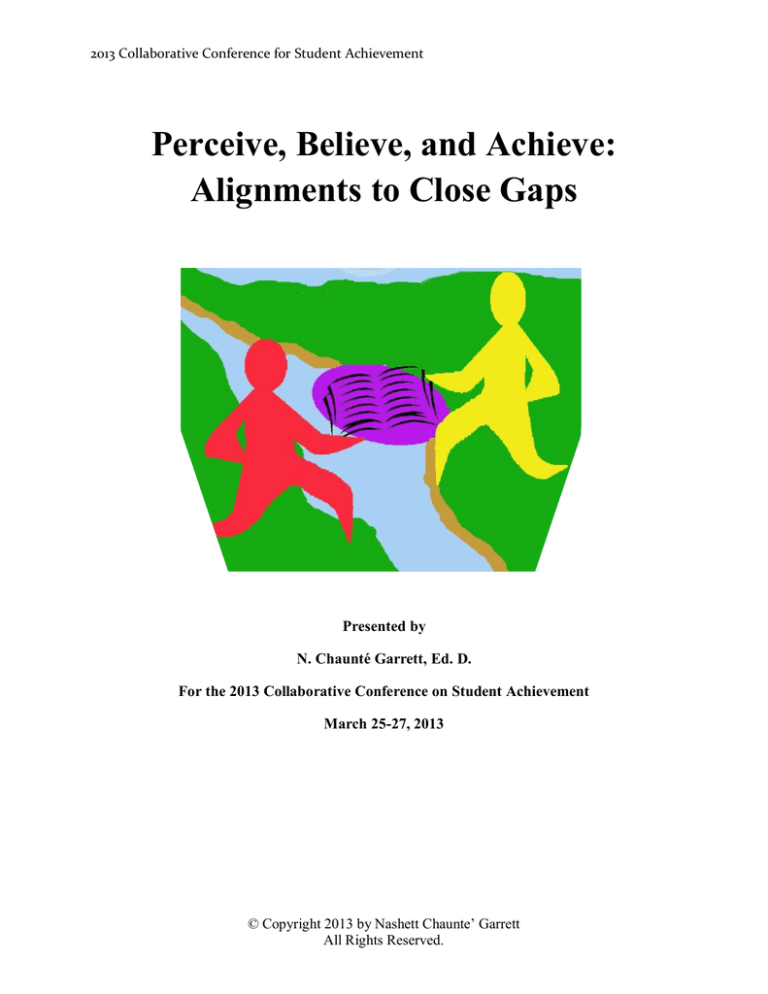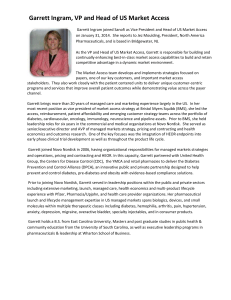
2013 Collaborative Conference for Student Achievement
Perceive, Believe, and Achieve:
Alignments to Close Gaps
Presented by
N. Chaunté Garrett, Ed. D.
For the 2013 Collaborative Conference on Student Achievement
March 25-27, 2013
© Copyright 2013 by Nashett Chaunte’ Garrett
All Rights Reserved.
2013 Collaborative Conference for Student Achievement
Perceive, Believe, and Achieve: Alignments to Close Gaps
2013 Collaborative Conference Goals addressed:
Supporting 21st century professionals to create a culture of high expectations
Supporting academic growth for all students
Engaging community stakeholders in transforming the education in North Carolina to
prepare globally competitive students for the 21st century
Presentation Outcomes:
Participants will:
Understand how varying experiences and perceptions of the academic achievement gap
influence the approach of educators to increase student achievement for all students.
Understand how district and school leaders successfully align their work to close
academic achievement gaps.
Describe your experiences with the Academic Achievement gap.
Describe some of the actions you take as an educator to close the academic achievement gap.
How do you define the academic achievement gap?
© Copyright 2013 by Nashett Chaunte’ Garrett
All Rights Reserved.
2013 Collaborative Conference for Student Achievement
The academic achievement gap is a result of:
Home
School
Policy
Academic Achievement Gap Definition
The academic achievement gap is the difference in achievement between all subgroups of
students (ethnic, ability, and economic) as determined by standardized test scores.
Reflection: In what ways do your actions as an educator address the academic achievement gap
as defined above?
Categories of Academic Achievement Gaps
Other Perspectives
Factors Contributing to the Academic Achievement Gap
© Copyright 2013 by Nashett Chaunte’ Garrett
All Rights Reserved.
2013 Collaborative Conference for Student Achievement
How do Educators begin to address the Academic Achievement Gap?
Organizational Structure of Some School Systems
© Copyright 2013 by Nashett Chaunte’ Garrett
All Rights Reserved.
2013 Collaborative Conference for Student Achievement
The Misalignment of Practices to Close the Academic Achievement Gap
© Copyright 2013 by Nashett Chaunte’ Garrett
All Rights Reserved.
2013 Collaborative Conference for Student Achievement
Implications
Acknowledge the existence
of racism:
Critical race theory
Professional development to
address biases and barriers
Seek, train, retain employees
that implement culturally
sound educational practices
Create a means of
eliminating the academic
achievement gap so that it
seems achievable
Establish consistent and
streamlined measures of the
academic achievement gap
Partnerships for experiences
and resources
Alignment of responsibilities
of each stakeholder
Student input and buy-in
A framework or plan for
closing the academic
achievement gap
Identifying the institutional
contributors to the academic
achievement gap
© Copyright 2013 by Nashett Chaunte’ Garrett
All Rights Reserved.
2013 Collaborative Conference for Student Achievement
References
ABSTRACT
GARRETT, NASHETT CHAUNTE. A Study of the Perceptions of School System Personnel of
the Academic Achievement Gap and How Their Perceptions Influence Their Educational
Practices. (Under the direction of Dr. Lance Fusarelli)
The case study takes place in a North Carolina School district diverse in student population and
land use, which by some records is experiencing some success with the students it serves.
Standardized test data reveals the existence of academic achievement gaps within schools
throughout the district. The school district’s superintendent declared “closing academic
achievement gaps” as a part of the district’s strategic plan. This study examines the perceptions
of educators at various levels of service and how their perceptions influence their educational
practices through a qualitative methodology. Interviews and focus groups were conducted with
the superintendent, regional superintendents and principals of each of the five regions within the
district. Board of Education minutes as well as documents provided by the participants were
analyzed. Participant responses were recorded, transcribed, and analyzed based on the study’s
conceptual framework, problem definition, into themes: perceptions, reality, solutions and
practices. Regional findings were used to create a case of the region based on the similarities and
differences of participants’ responses. A cross-case analysis of the data was conducted to create a
case of the school district. Although the administrators of the district provided a common
definition of the academic achievement gap, the way the administrators frame the issue of the
academic achievement gap is different hence their approaches to resolving the issue of the
academic achievement gap is different as well.
© Copyright 2013 by Nashett Chaunte’ Garrett
All Rights Reserved.





